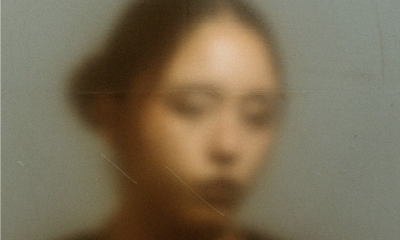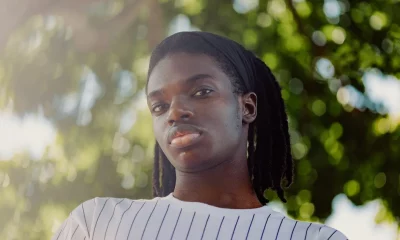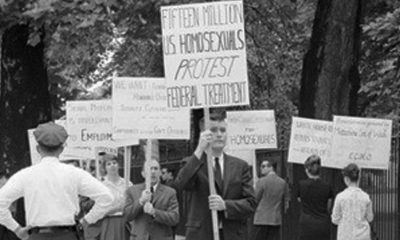a&e features
The ‘Stonewall’ brouhaha
Director says he’s proud of film, despite activist backlash
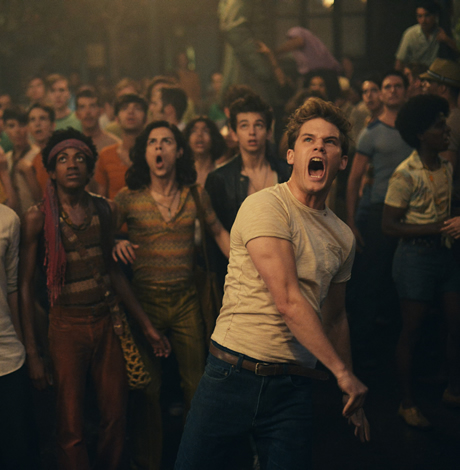
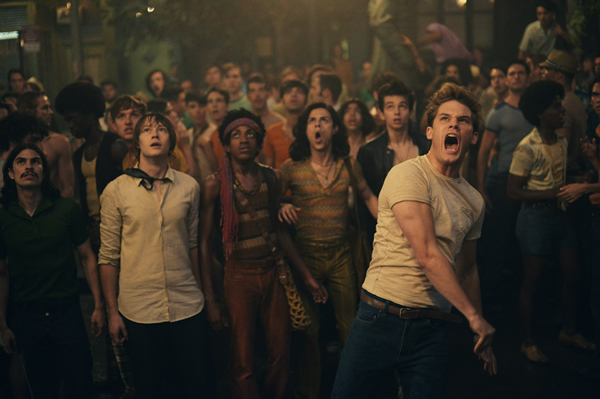
Jeremy Irvine as Danny in ‘Stonewall,’ throws the first brick. The filmmakers have drawn considerable ire for centering the action around Danny, a fictional character. (Photo courtesy Roadside Attractions)
When the world got its first look at the “Stonewall” trailer in August, reaction was swift and withering with some even calling for LGBT people to boycott the film, a dramatization of the 1969 New York riots that were a turning point for gay rights.
The film was assailed, from snarky social media posts (“Ah yes! That wonderful point in gay history where super models got really angry”) to outright vitriol. Pat Cordova-Goff, who identifies as a “transwomyn of color” is calling for a boycott with the Gay-Straight Alliance Network. “Do not throw money at the capitalistic industry that fails to recognize true s/heros. Do not support a film that erases our history. Do not watch ‘Stonewall,’” she writes.
The beefs are essentially that historical events have been “whitewashed,” that trans characters are pushed to the sidelines and played by non-trans actors and that, as Tim Teeman wrote for the Daily Beast, “everyone appears to have been bused in from laughably predictable central casting.” The events are centered around a fictional character named Danny, a white Midwestern teen kicked out of his home for being gay. Ironically, few have pointed out that Jeremy Irvine, the 25-year-old “War Horse” actor who plays him, is straight.
Irvine, director Roland Emmerich and writer Jon Robin Baitz (all white, the latter two gay) have defended the film, which opens on Friday, Sept. 25 (it’s screening at area theaters such as Landmark E Street Cinema, ArcLight Bethesda, Angelika Film Center and more). They counter that most of the criticism is based on the trailer, not the film itself, that the true events of the riots are shrouded in myth and that any dramatization uses artistic license to varying degrees. Legendary gay writer Larry Kramer defended the filmmakers.
Emmerich, widely known for helming major films like “Independence Day” (1996), “Godzilla” (1998) and the Mel Gibson vehicle “The Patriot” (2000), is already at work on his next project. The German-born auteur spoke to the Blade by phone from his Los Angeles home. His comments have been slightly edited for length.
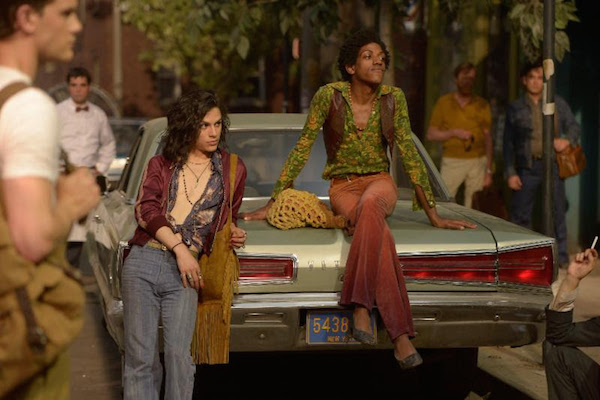
Jonny Beauchamp, left, as Ray, and Vlad Alexis as Cong in ‘Stonewall.’ Although the filmmakers have been accused of ‘whitewashing’ history, it does include several Latino and African-American gender-nonconforming characters. (Photo courtesy Roadside Attractions)
WASHINGTON BLADE: What was the genesis of “Stonewall”?
ROLAND EMMERICH: Actually a producer friend of mine, Michael Fossat, proposed it to me. I was kind of like, “I don’t know, with so many great gay directors, why should I do a gay movie?” But then I started checking it out and read a lot and at the same time I took a tour of the Los Angeles Gay & Lesbian Center and saw the homeless youth program and I realized that 40 percent of homeless youth are LGBT. Compared to the overall population, that’s actually quite a big number and so slowly I kind of started thinking that maybe this is something for me. We started looking for a writer and I read this terrific play by Robbie Baitz and it kind of came together. First we wrote a script and then we took it from there.
BLADE: The trailer got a lot of criticism. Did it give the wrong impression of the film or were people too quick to judge the film based on it?
EMMERICH: I like the trailer. We premiered it at the GLAAD awards and it got a standing ovation. Nobody had any criticism of it there. It’s very unfortunate that some people kind of felt it was kind of some sort of whitewashing, but it isn’t. The film itself uses a white character as a catalyst but the film itself is actually quite ethnically diverse. It has, you know, like all facets of the LGBT community both historic and invented. I didn’t comment on it much because I really felt I didn’t want to comment on criticism of the trailer.
BLADE: I’m not a filmmaker. What dramatic purpose does it serve to have a character such as Danny to center the action around? Why was that a device you wanted to utilize?
EMMERICH: Well, a friend of mine told me his story and that interested me a lot because it’s still a story that happens today with kids getting thrown out of their homes for being gay. These are often quaint kind of middle-class homes and then they end up on the street and I just felt that would be a unique approach because these stories show that you can be in that situation and hold on to your dignity and your dream and not lose them in the process. So it was a coming-of-age story with kids, which I could imagine very well. Also, the overall theme was one of unrequited love. When you look at the movie, it’s a lot about people who love somebody and it’s not that the other person doesn’t love them, but they cannot be together and yet at the end they all come together and create something great. That was overall, dramatically, I’d say, when I started with Robbie, you first talk about the approach you want to take. We are also big (J.D.) Salinger fans and he was a big writer in the ‘60s, you know. So that was a type of an influence, and it all came together from there. When you do your research on this, you realize there’s not really one standout character in these riots. I loved the idea that it was this group of homeless kids that we know about who were part of it. Just an overall riot of many people who had just had it. You know how riots happen. It was actually really sparked by a lesbian who resisted arrest. That’s what really threw everything into high gear.
BLADE: Theoretically could the film have worked with somebody like Marsha P. Johnson as the protagonist? Could you have gotten a green light with that approach?
EMMERICH: Well we never did get a green light. I gave my own green light. I love the Marsha P. Johnson character. I have friends who are trans women, but it felt to me like I’m a white male, I’m openly gay and we can have all forms of sexuality in this film, but I think it’s good to use somebody very close to yourself, you know, and find truth in that. We also didn’t want to make the Jonny Beauchamp character (Ray, a composite) as just Sylvia Rivera because she was the one who said she was at the Stonewall that night. I didn’t want to invent stuff around Sylvia. She was not a club kid and didn’t really have any relationship like that. So all this kind of came together through discussions and we used a lot of historical characters but also with these invented characters. I thought it was a better approach, at least for me, to show the feel this time had. We talked to some Stonewall veterans and we only found white guys, you know? I think actually there was one who wanted to call me but then this person died shortly after.
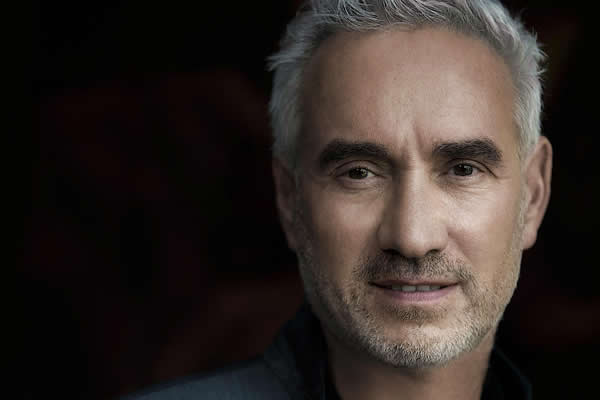
Director Roland Emmerich says ‘Stonewall,’ despite its relatively small budget, was a tough film to get made. (Photo courtesy Roadside Attractions)
BLADE: How was the shoot?
EMMERICH: Well it was odd because we wanted to make it first on location in New York but it was too expensive and we found they’d never let us do what we wanted to do there. … New York is a very expensive town. So we ended up doing it in Montreal where we were able to use some Canadian actors and get a huge tax rebate. Once we decided to film it there, everything came together nicely. We had a very nice shoot, like 42 days, and it was one, big, happy family.
BLADE: Was it hard to get it financed?
EMMERICH: It was about $17 million and we got like $4 million back in tax rebates and the rest we did as a pre-sale to Germany and other countries. A friend of mine and I put in the rest. We went to all my usual contacts and they all said, “Oh, this is too niche, there’s no real big name in it,” and blah, blah, blah.
BLADE: Are the Hollywood bean counters squeamish about gay themes or is there a legit point in the math?
EMMERICH: No, they’re not. When somebody like, you know, Sean Penn takes on Harvey Milk, they’re all there because they know that’s an actor who can win an Oscar. So there’s more incentive to do films like that where the actor can be the incentive. They also say things like, “Why is he making a movie like that, why is he not making one of his big movies where we can make a lot of money?” And I’m saying, “I will make those movies, but I want to make other movies too.” I like these smaller projects sometimes, like “Anonymous.” Nobody wanted me to do that one either, but it’s fine.
BLADE: What’s it like making a small film like “Stonewall” versus a big-budget action spectacle like “Independence Day?” Do the headaches increase with the scope as one might expect or not necessarily?
EMMERICH: I think it is more complex making a film like “Independence Day” because you’re dealing with a little bit more complex techniques, like shooting half the movie on bluescreen, where it’s very, very tough to keep the actors involved. “Stonewall” was a very different method, a very old-fashioned method actually, where we actually built the street and everything, then in the back we had some photographic backgrounds and maybe only one or two scenes were bluescreen, the march and one other scene. It was a very gritty atmosphere on the set and I think the actors get something out of that. … I got a lot of knowledge working on those big movies that I could use in “Stonewall,” you know? I just kind of know how to make things realistic looking when they’re not.
BLADE: Sometimes controversy works in your favor. Will it help you here?
EMMERICH: Maybe it brought more attention to the film. I don’t know if people would have known about it otherwise. Now at least the gay people know. Sometimes a controversy works against you and sometimes it works for you. We won’t know till it comes out. It’s an interesting dynamic. Nobody knows what will happen but you never know this with any movie what will happen. I’m quite content. I’m already making my next movie. I’m very proud of the movie we did and everybody who was involved.
BLADE: How much straight support will the movie need to be successful?
EMMERICH: That will be a very interesting thing. … When we tested the movie, it actually tested better with straight people than gay because straight people don’t have all this sense of they think they know what it was about. Gay people think, “Oh, it was because Judy Garland died,” and they think they know the story, where as straight audiences don’t think like that. They think, “What was the story like and how did I get into the story and what did I learn?” They were actually amazed at how emotional they got in the story. I hope for a wider audience but it’s also not a big release. It’s like a 100-print release, so it’s perfect for me. We’ll see what happens.
BLADE: Have you been out your entire career?
EMMERICH: At the beginning in Germany I wasn’t out because I never wanted to become the gay director and it was kind of a typical thing in Germany, if you were out it was like you were a gay director and you only did gay movies, so I didn’t think it was good to come out. It was also a different time. Then I came to America and, of course, my friends knew, but at a certain point I realized I’m making big movies, I can be out, so I came out. This was like maybe 20 years ago, which was a bit late. I’m 59 turning 60, so it was a little different time. For me, “Stonewall” represents this mythical moment. I went to Christopher Street the first time I was in New York and stood in front of the Stonewall and it was always kind of like Germany to me. A little bit of this coming out, this proud moment because of what happened there.
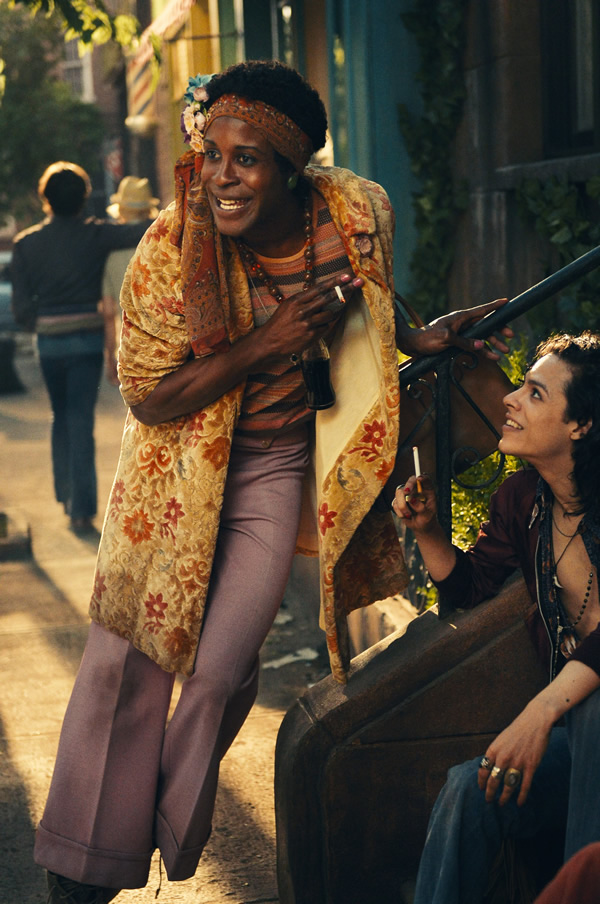
Otoja Abit as Marsha P. Johnson in ‘Stonewall.’ (Photo by Philippe Bossé; courtesy of Roadside Attractions)
a&e features
Queer highlights of the 2026 Critics Choice Awards: Aunt Gladys, that ‘Heated Rivalry’ shoutout and more
Amy Madigan’s win in the supporting actress category puts her in serious contention to win the Oscar for ‘Weapons’

From Chelsea Handler shouting out Heated Rivalry in her opening monologue to Amy Madigan proving that horror performances can (and should) be taken seriously, the Critics Choice Awards provided plenty of iconic moments for queer movie fans to celebrate on the long road to Oscar night.
Handler kicked off the ceremony by recapping the biggest moments in pop culture last year, from Wicked: For Good to Sinners. She also made room to joke about the surprise hit TV sensation on everyone’s minds: “Shoutout to Heated Rivalry. Everyone loves it! Gay men love it, women love it, straight men who say they aren’t gay but work out at Equinox love it!”
The back-to-back wins for Jacob Elordi in Frankenstein and Amy Madigan in Weapons are notable, given the horror bias that awards voters typically have. Aunt Gladys instantly became a pop culture phenomenon within the LGBTQ+ community when Zach Cregger’s hit horror comedy released in August, but the thought that Madigan could be a serious awards contender for such a fun, out-there performance seemed improbable to most months ago. Now, considering the sheer amount of critics’ attention she’s received over the past month, there’s no denying she’s in the running for the Oscar.
“I really wasn’t expecting all of this because I thought people would like the movie, and I thought people would dig Gladys, but you love Gladys! I mean, it’s crazy,” Madigan said during her acceptance speech. “I get [sent] makeup tutorials and paintings. I even got one weird thing about how she’s a sex icon also, which I didn’t go too deep into that one.”
Over on the TV side, Rhea Seehorn won in the incredibly competitive best actress in a drama series category for her acclaimed performance as Carol in Pluribus, beating out the likes of Emmy winner Britt Lower for Severance, Carrie Coon for The White Lotus, and Bella Ramsey for The Last of Us. Pluribus, which was created by Breaking Bad’s showrunner Vince Gilligan, has been celebrated by audiences for its rich exploration of queer trauma and conversion therapy.
Jean Smart was Hack’s only win of the night, as Hannah Einbinder couldn’t repeat her Emmy victory in the supporting actress in a comedy series category against Janelle James, who nabbed a trophy for Abbott Elementary. Hacks lost the best comedy series award to The Studio, as it did at the Emmys in September. And in the limited series category, Erin Doherty repeated her Emmy success in supporting actress, joining in yet another Adolescence awards sweep.
As Oscar fans speculate on what these Critics Choice wins mean for future ceremonies, we have next week’s Golden Globes ceremony to look forward to on Jan. 11.
a&e features
Looking back at the 10 biggest A&E stories of 2025
‘Wicked,’ Lady Gaga’s new era, ‘Sexy’ Bailey and more

Although 2025 was a year marked by countless attacks on trans rights and political setbacks, the year also saw brilliant queer artists continuing to create art. From Cannes and Sundance Award winners now vying for Oscar consideration to pop icons entering new stages of their careers, queer people persevered to tell their stories through different media.
With the state of the world so uncertain, perhaps there’s no more vital time to celebrate our wins, as seen through some of this year’s top pop culture moments. While there’s no collection of 10 stories that fully encompass “the most important” news, here are some events that got the gays going:
10. ‘Mysterious Gaze of the Flamingo’ wins big at Cannes

The Cannes Film Festival has become a crucial start for films hoping to make their way to the Oscars, and first-time director Diego Céspedes won the top Un Certain Regard prize for his intimate western “The Mysterious Gaze of the Flamingo.” The film is set in the ‘80s and is intended as an allegory for the AIDS epidemic. Seeing a film that unpacks vital queer history win one of the most coveted awards at Cannes has been a huge point of pride in the independent filmmaking community.
Since the film bowed at Cannes, it has been selected as Chile’s Oscar entry in the Best International Feature race. Speaking with The Blade during the film’s AFI Fest run in October, Céspedes said: At first, I was kind of scared to have this campaign position in the times that we’re living [in] here. But at the same time, I think the Oscars mean a huge platform — a huge platform for art and politics.”
9. ‘The Last of Us’ returns for an even gayer season 2
While the first season of The Last of Us gave us one of TV’s most heartbreaking queer love stories in the episode “Long, Long Time,” Season 2 doubled down on its commitment to queer storytelling with the blossoming relationship between Ellie (Bella Ramsey) and Dina (Isabela Merced). The show expanded on the pair’s relationship in the original video game, making it perhaps the central dynamic to the entire season. That unfortunately came with more homophobic backlash on the internet, but those who checked out all the episodes saw a tender relationship form amid the show’s post-apocalyptic, often violent backdrop. For their performance, Ramsey was once again nominated for an Emmy, but Merced deserved just as much awards attention.
8. ‘Emilia Pérez’ sparks controversy
Jacques Audiard’s genre-bending trans musical “Emilia Pérez” proved to be an awards season juggernaut this time last year, winning the Golden Globe for Best Musical/Comedy. But when the lead star Karla Sofia Gascón’s racist, sexist, and homophobic old tweets resurfaced, the film’s Oscar campaign became a tough sell, especially after Netflix had tried so hard to sell Emilia Pérez as the “progressive” film to vote for. Mind you, the film had already received significant backlash from LGBTQ+ audiences and the Mexican community for its stereotypical and reductive portrayals, but the Gascón controversy made what was originally just social media backlash impossible to ignore. The only person who seemed to come out of the whole debacle unscathed was Zoe Saldaña, who won the Oscar for Best Supporting Actress over Ariana Grande.
7. ‘Sorry, Baby’ establishes Eva Victor as major talent
Back in January at the Sundance Film Festival, Eva Victor (known by many for her brand of sketch comedy) premiered their directorial debut “Sorry, Baby” to rave reviews, even winning the Waldo Salt Screening Award. Victor shadowed Jane Schoenbrun on the set of “I Saw the TV Glow,” and seeing Victor come into their own and establish such a strong voice immediately made them one of independent cinema’s most exciting new voices. A memorable scene in the film sees the main character, Agnes (played by Victor), struggling to check a box for male or female, just one example of how naturally queerness is woven into the fabric of the story.
Most recently, Victor was nominated for a Golden Globe for her performance in the film, and she’s represented in a category alongside Jennifer Lawrence (“Die My Love”), Jessie Buckley (“Hamnet”), Julia Roberts (“After the Hunt”), Renate Reinsve (“Sentimental Value”) and Tessa Thompson (“Hedda”). The film also received four Independent Spirit Award nominations overall.
6. Paul Reubens comes out in posthumous doc

While Paul Reubens never publicly came out as gay before passing away in 2023, the two-part documentary “Pee-wee as Himself” premiered back in May on HBO Max, giving the legendary comedian a chance to posthumously open up to the world. Directed by Matt Wolf, the documentary explores how Reubens found his alter ego Pee-Wee Herman and why he kept his private life private.
The documentary won an Emmy in the Outstanding Documentary or Nonfiction Special category and remains one of the most critically acclaimed titles of the year with a 100% Rotten Tomatoes score. Also worth noting, the National Geographic documentary Sally told the posthumous coming out story of Sally Ride through the help of her long-time partner, Tam O’Shaughnessy.
5. Lady Gaga releases ‘Mayhem’
Lady Gaga entered a new phase of her musical career with the release of Mayhem, her seventh album to date. From the frenzy-inducing pop hit Abracadabra to the memorable Bruno Mars duet featured on “Die With a Smile,” seeing Gaga return to her roots and make an album for the most die-hard of fans was especially rewarding after the underwhelming film releases of “House of Gucci” and “Joker: Folie à Deux.” Gaga has been touring with The Mayhem Ball since July, her first arena tour since 2018. She even extended her tour into 2026 with more North American dates, so the party isn’t stopping anytime soon. And Gaga is even set to make an appearance next May in “The Devil Wears Prada 2.”
4. Cynthia Erivo, Ariana Grande perform at the Oscars

While “Wicked: For Good” didn’t quite reach the heights of the first film, we will forever have Cynthia Erivo and Ariana Grande’s breathtaking live performance that opened the 97th Academy Awards. The pair sang a rendition of “Over the Rainbow,” “Home,” and “Defying Gravity,” paying proper homage to the original 1939 “Wizard of Oz.” Even non-Wicked fans can’t deny how magical and brilliantly staged this performance was. With both Erivo and Grande up for acting Oscars last year, they’re hoping to repeat success and make history with consecutive nominations. Either way, let’s hope there’s another live performance in the making, especially with two new original songs (The Girl in the Bubble and No Place Like Home) in the mix.
3. Indya Moore speaks out against Ryan Murphy
Indya Moore has consistently used social media as a platform for activism, and in September, posted a 30-minute Instagram live speaking out against “Pose” co-creator Ryan Murphy. Moore claimed that Murphy wasn’t being a true activist for trans people. “Ryan Murphy, we need you to do more. You need to address the racism, the violence, and the targeting of people on your productions, Ryan Murphy. You do need to make sure trans people are paid equally. Yes, Janet did the right thing,” Moore said. Murphy was also back in the headlines this year for the critically panned “All’s Fair” and the controversial “Monster: The Ed Gein Story” starring Laurie Metcalf and Charlie Hunnam.
2. Cole Escola wins Tony for Best Leading Actor
Few pop culture moments this year brought us together more than Cole Escola winning a Tony award for “Oh, Mary!” the Broadway show they created, wrote and starred in (we love a triple threat!) Escola made history by becoming the first nonbinary person to win a Tony in the leading actor category, and seeing them excitedly rush to the stage wearing a Bernadette Peters-inspired gown instantly became a viral social media moment.
The cherry on top of Escola’s major moment is the recent news that they are writing a Miss Piggy movie with Jennifer Lawrence and Emma Stone producing — news that also broke the internet for the better. We cannot wait!
1. Jonathan Bailey makes gay history as ‘Sexiest Man Alive’

The same year as his on-screen roles in blockbusters “Jurassic World Rebirth” and “Wicked: For Good,” Jonathan Bailey made history as the first openly gay man to be named People magazine’s “Sexiest Man Alive.” The fact that it took 40 years for an openly gay man to earn the title is a signifier of how far we still have to go with queer representation, and seeing Bailey celebrated is just one small step in the right direction.
“There’s so many people that want to do brilliant stuff who feel like they can’t,” he told PEOPLE, “and I know the LGBT sector is under immense threat at the moment. So it’s been amazing to meet people who have the expertise and see potential that I could have only dreamed of.” In 2024, Bailey founded the charity titled The Shameless Fund, which raises money for LGBTQ+ organizations.
a&e features
Your guide to D.C.’s queer New Year’s Eve parties
Ring in 2026 with drag, leather, Champagne, and more

With Christmas in the rear view mirror, we can turn our attention to ringing in a much-anticipated New Year with a slew of local LGBTQ parties. Here’s what’s on tap.
Pitchers
This spacious Adams Morgan bar is hosting the “Pitchers’ Perfect New Year’s Eve.” There will be a midnight Champagne toast, the ball drop on the big screens, and no cover, all night long. The bar doesn’t close until 4 a.m., and the kitchen will be open late (though not until close). All five floors will be open for the party, and party favors are promised.
Trade
D.C.’s hottest bar/club combo is leaning into the Shark motif with its NYE party, “Feeding Frenzy.” The party is a “glitterati-infused Naughty-cal New Year’s Even in the Shark Tank, where the boats are churning and the sharks are circling.” Trade also boasts no cover charge, with doors opening at 5 p.m. and the aforementioned Shark Tank opening at 9 p.m.. Four DJs will be spread across the two spaces; midnight hostess is played by Vagenesis and the two sea sirens sensuously calling are Anathema and Justin Williams.
Number Nine
While Trade will have two DJs as part of one party, Number Nine will host two separate parties, one on each floor. The first floor is classic Number Nine, a more casual-style event with the countdown on TVs and a Champagne midnight toast. There will be no cover and doors open at 5 p.m. Upstairs will be hosted by Capital Sapphics for its second annual NYE gathering. Tickets (about $50) include a midnight Champagne toast, curated drink menu, sapphic DJ set by Rijak, and tarot readings by Yooji.
Crush
Crush will kick off NYE with a free drag bingo at 8 p.m. for the early birds. Post-bingo, there will be a cover for the rest of the evening, featuring two DJs. The cover ($20 limited pre-sale that includes line skip until 11 p.m.; $25 at the door after 9 p.m.) includes one free N/A or Crush, a Champagne toast, and party favors (“the legal kind”). More details on Eventbrite.
Bunker
This subterranean lair is hosting a NYE party entitled “Frosted & Fur: Aspen After Dark New Year’s Eve Celebration.” Arriety from Rupaul Season 15 is set to host, with International DJ Alex Lo. Doors open at 9 p.m. and close at 3 p.m.; there is a midnight Champagne toast. Cover is $25, plus an optional $99 all-you-can-drink package.
District Eagle
This leather-focused bar is hosting “Bulge” for its NYE party. Each District Eagle floor will have its own music and vibe. Doors run from 7 p.m.-3 a.m. and cover is $15. There will be a Champagne toast at midnight, as well as drink specials during the event.
Kiki, Shakiki
Kiki and its new sister bar program Shakiki (in the old Shakers space) will have the same type of party on New Year’s Eve. Both bars open their doors at 5 p.m. and stay open until closing time. Both will offer a Champagne toast at midnight. At Kiki, DJ Vodkatrina will play; at Shakiki, it’ll be DJ Alex Love. Kiki keeps the party going on New Year’s Day, opening at 2 p.m., to celebrate Kiki’s fourth anniversary. There will be a drag show at 6 p.m. and an early 2000s dance party 4-8 p.m.
Spark
This bar and its new menu of alcoholic and twin N/A drinks will host a NYE party with music by DJ Emerald Fox. Given this menu, there will be a complimentary toast at midnight, guests can choose either sparkling wine with or without alcohol. No cover, but Spark is also offering optional wristbands at the door for $35 open bar 11 p.m.-1 a.m. (mid-shelf liquor & all NA drinks).

